Insights into Social Inequality: ROOTS 01
Autor Ralph Grossmannen Limba Engleză Paperback – 10 iun 2021
| Toate formatele și edițiile | Preț | Express |
|---|---|---|
| Paperback (1) | 389.40 lei 38-45 zile | |
| Sidestone Press Academics – 10 iun 2021 | 389.40 lei 38-45 zile | |
| Hardback (1) | 705.88 lei 38-45 zile | |
| Sidestone Press Academics – 10 iun 2021 | 705.88 lei 38-45 zile |
Preț: 389.40 lei
Preț vechi: 458.12 lei
-15% Nou
Puncte Express: 584
Preț estimativ în valută:
74.51€ • 78.08$ • 61.60£
74.51€ • 78.08$ • 61.60£
Carte tipărită la comandă
Livrare economică 07-14 aprilie
Preluare comenzi: 021 569.72.76
Specificații
ISBN-13: 9789088909771
ISBN-10: 9088909776
Pagini: 240
Dimensiuni: 210 x 280 x 16 mm
Greutate: 0.75 kg
Editura: Sidestone Press Academics
Colecția ROOTS 01
Seria ROOTS 01
ISBN-10: 9088909776
Pagini: 240
Dimensiuni: 210 x 280 x 16 mm
Greutate: 0.75 kg
Editura: Sidestone Press Academics
Colecția ROOTS 01
Seria ROOTS 01
Notă biografică
Ralph Grossmann is currently a Postdoctoral Fellow of the Excellence Cluster ROOTS at Kiel University and he is a member of the Subcluster Social Inequality. From March to August 2020, he held a position as a deputy scientific coordinator of the Excellence Cluster ROOTS. He was a member of the Graduate School ¿Human Development in Landscapes¿ from 2010 to 2018 and obtained his doctoral degree in philosophy in 2016 at Kiel University with an analysis on Corded Ware and Bell Beaker burials in the German Rhine and Saale regions.
Descriere
This work examines social inequalities in a diachronic and multivariate approach based on burial grounds in Southwestern Germany.
